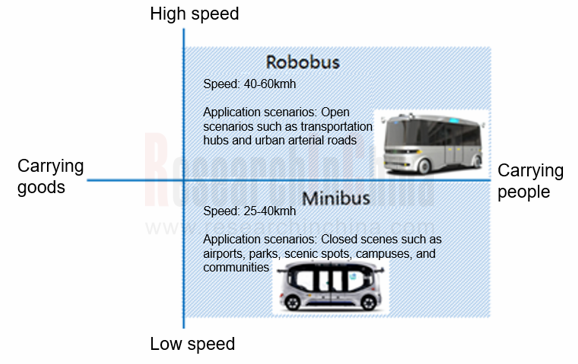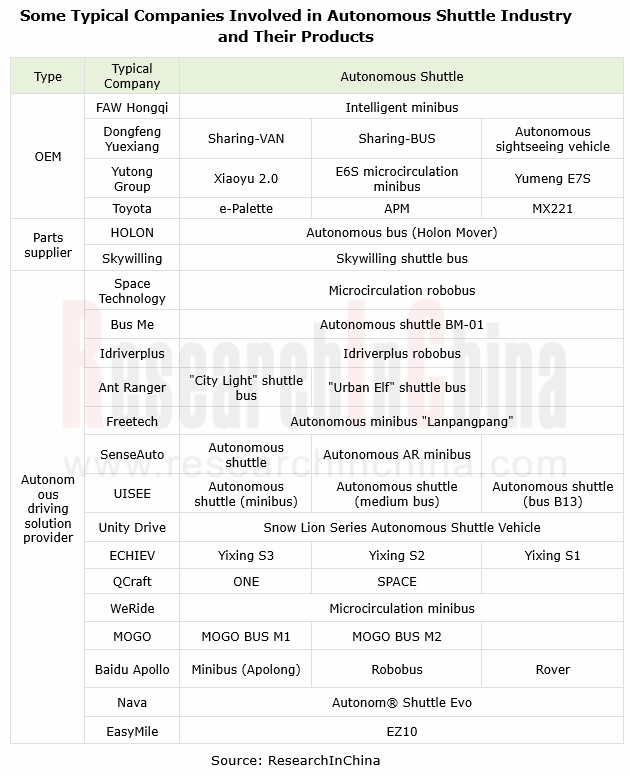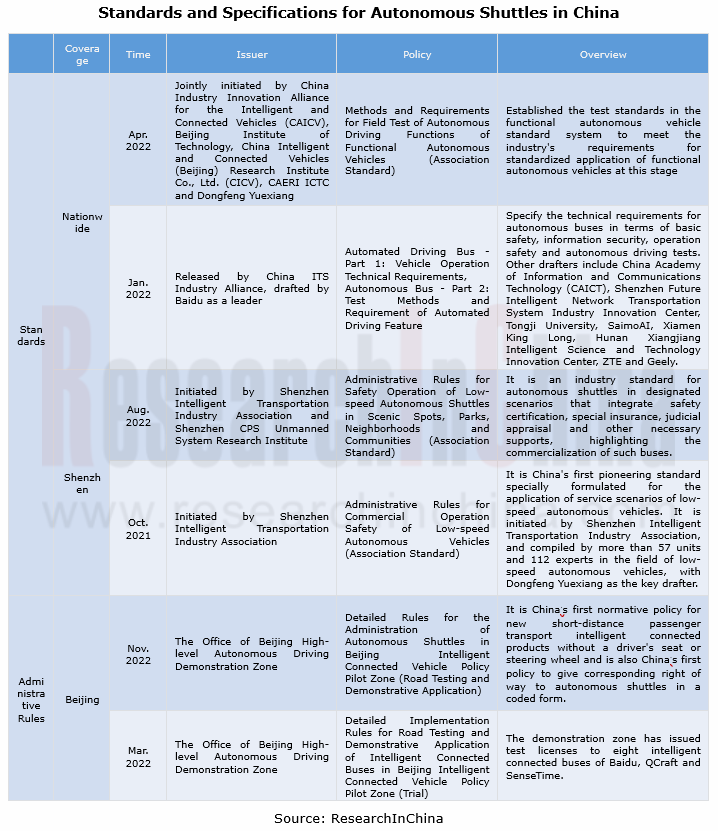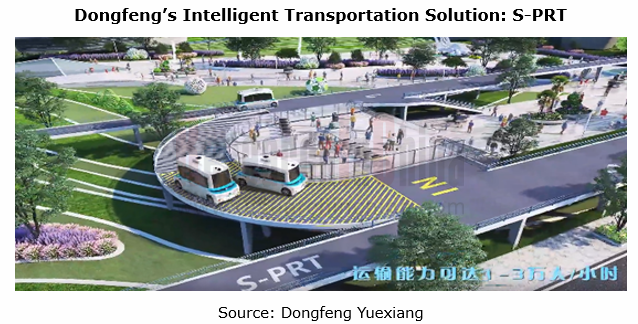Autonomous Shuttle Research: application scenarios further extend amidst policy promotion and continuous exploration
Autonomous shuttles are roughly categorized into minibuses and robobuses. Minibuses, namely micro-circulation shuttle buses, mostly work in airports, parks, scenic spots, campuses, communities and other scenarios at speeds of 25-45km/h. Typical minibuses are offered by FAW Hongqi, Baidu Apollo and UISEE.
Robobuses are autonomous minibuses running at 40-60 km/h under the control of software. They are often seen in open scenarios such as transportation hubs and urban trunk roads, and provide urban public transport services. Representative robobuses include Qcraft ONE and MOGO BUS M2.

I. Autonomous driving solution providers flood into the arena of shuttle buses.
In the arena of shuttle buses, main players embrace OEMs, auto parts companies and autonomous driving solution providers, among which L4 autonomous driving technology providers perform stunningly. For example, the robobus co-built by Shanghai Space and PIX Moving was delivered offline in March 2022, and officially began to provide short-distance shuttle services between Wangjiazhuang Subway Station and Xiantao Big Data Valley, Yubei District, Chongqing in June 2022. In July 2022, the driverless buses from Idriverplus landed in Beijing Dongsheng Science and Technology Park to start the normal operation and serve commuters in the park. In September 2022, MOGO officially released the autonomous OEM production buses - MOGO BUS M1 (autonomous minibus) and MOGO BUS M2 (autonomous bus), both equipped with the "vehicle-road-cloud integration" system.

As well robotaxises that adopt L4 technology, autonomous shuttles boast sensors such as LiDAR, radar and cameras, and combine cloud software and sensors to enable vehicle positioning, environmental perception, path planning & decision, and vehicle control & actuation. At present, many L4 technical solution providers like QCraft, UISEE, MOGO, WeRide and Baidu Apollo have laid out technology routes for both robotaxis and robobuses.
II. The operation scenarios of autonomous shuttles are extending from designated areas and low-speed scenarios to open environments and complex scenarios.
At present, autonomous shuttles are running from closed and semi-closed designated areas (parks, scenic spots, factories, communities, campuses, airports, etc.) to urban public roads as subway shuttle buses, urban microcirculation buses, and autonomous buses for ride-hailing services.

III. The current growth of the autonomous shuttle market is mainly driven by policies and smart road upgrades.
1. China, the United States, Japan, and South Korea have issued favorable policies for autonomous buses.
Japan, the United States and South Korea among other foreign countries have introduced policies to encourage the commercial operation of autonomous vehicles like autonomous shuttles.
 On March 10, 2022, the National Highway Traffic Safety Administration (NHTSA) of the United States issued a first-of-its-kind final rule, the Occupant Protection Safety Standards for Vehicles Without Driving Controls, no longer requiring automated vehicle manufacturers to equip their ADS-enabled vehicles with traditional manual controls to meet crash standards.
On March 10, 2022, the National Highway Traffic Safety Administration (NHTSA) of the United States issued a first-of-its-kind final rule, the Occupant Protection Safety Standards for Vehicles Without Driving Controls, no longer requiring automated vehicle manufacturers to equip their ADS-enabled vehicles with traditional manual controls to meet crash standards.
 Japan decided to allow for use of L4 autonomous vehicles (controlled by system) in transit and delivery services from April 1, 2023.
Japan decided to allow for use of L4 autonomous vehicles (controlled by system) in transit and delivery services from April 1, 2023.
 South Korea proposed a goal of commercializing L4 (highly automated) autonomous buses and shuttle buses by 2025 under its “Mobility Innovation Roadmap”. On November 25, 2022, Seoul, capital of South Korea, opened the first autonomous bus line with a total mileage of about 3.4 kilometers, marking South Korea’s first step to commercialize autonomous shuttles.
South Korea proposed a goal of commercializing L4 (highly automated) autonomous buses and shuttle buses by 2025 under its “Mobility Innovation Roadmap”. On November 25, 2022, Seoul, capital of South Korea, opened the first autonomous bus line with a total mileage of about 3.4 kilometers, marking South Korea’s first step to commercialize autonomous shuttles.
In China, Beijing, Shenzhen and other cities have standardized autonomous shuttles in terms of product standards and administration, setting an example for the development of the industry.
 In January 2022, the "Automated Driving Bus” association standard jointly drafted by Baidu, China Academy of Information and Communications Technology (CAICT), ZTE and Geely was officially released. This standard covers two parts: Automated Driving Bus - Part 1: Vehicle Operation Technical Requirements, and Autonomous Bus - Part 2: Test Methods and Requirement of Automated Driving Feature. They specify the technical requirements for autonomous buses in terms of basic safety, information security, operation safety and autonomous driving tests.
In January 2022, the "Automated Driving Bus” association standard jointly drafted by Baidu, China Academy of Information and Communications Technology (CAICT), ZTE and Geely was officially released. This standard covers two parts: Automated Driving Bus - Part 1: Vehicle Operation Technical Requirements, and Autonomous Bus - Part 2: Test Methods and Requirement of Automated Driving Feature. They specify the technical requirements for autonomous buses in terms of basic safety, information security, operation safety and autonomous driving tests.
 In March 2022, Beijing High-level Autonomous Driving Demonstration Zone issued the Detailed Implementation Rules for Road Testing and Demonstrative Application of Intelligent Connected Buses in Beijing Intelligent Connected Vehicle Policy Pilot Zone (Trial), posing specific administrative requirements for in-vehicle management, vehicle operation, road test, insurance and technical parameters.
In March 2022, Beijing High-level Autonomous Driving Demonstration Zone issued the Detailed Implementation Rules for Road Testing and Demonstrative Application of Intelligent Connected Buses in Beijing Intelligent Connected Vehicle Policy Pilot Zone (Trial), posing specific administrative requirements for in-vehicle management, vehicle operation, road test, insurance and technical parameters.
 In November, 2022, Beijing High-level autonomous driving Demonstration Zone issued the "Detailed Rules for the Administration of Autonomous Shuttles in Beijing Intelligent Connected Vehicle Policy Pilot Zone (Road Testing and Demonstrative Application)". It is China’s first normative policy for new short-distance passenger transport intelligent connected products without a driver's seat or steering wheel and is also China’s first policy to give corresponding right of way to autonomous shuttles in a coded form.
In November, 2022, Beijing High-level autonomous driving Demonstration Zone issued the "Detailed Rules for the Administration of Autonomous Shuttles in Beijing Intelligent Connected Vehicle Policy Pilot Zone (Road Testing and Demonstrative Application)". It is China’s first normative policy for new short-distance passenger transport intelligent connected products without a driver's seat or steering wheel and is also China’s first policy to give corresponding right of way to autonomous shuttles in a coded form.

2. The construction and upgrading of smart roads accelerate the large-scale application of autonomous shuttles.
The construction of smart roads is the premise for operating autonomous shuttles. In particular, the planning of smart bus lines in various urban demonstration areas has favored the application of robobuses. So far, Beijing, Xiong'an New Area, Guangzhou, Ezhou, Zibo, Changsha, Wuxi, Zhengzhou, Chongqing, Hainan and the like have taken the lead in introducing autonomous shuttles on the basis of smart roads.
As of September 2022, Wuhan Economic & Technological Development Zone had opened 321km test roads in total for intelligent connected vehicles, of which 106km is fully covered by 5G and CVIS. It had deployed more than 1,800 intelligent roadside units such as cameras, LiDARs, radars and edge computing servers at 96 smart intersections to support real-time information exchange between vehicles, between vehicles and roads, between vehicles and the Internet. Among the autonomous shuttles landing in Wuhan Economic & Technological Development Zone, more than 30 Sharing-VANs from Dongfeng Yuexiang have come into normal operation, travelling a total of over 209,000 kilometers.
Guangzhou has opened a total of 353 test sections for intelligent connected vehicles, with a cumulative one-way mileage of 654.451 kilometers and a two-way mileage of 1,308.902 kilometers. From August 2022 to December 2023, Guangzhou starts an autonomous driving pilot project for urban mobility, and introduces 50 autonomous buses from different companies on the loop lines around Canton Tower and Guangzhou International Bio Island, providing at least 1 million rides for passengers.
Accompanied by the construction and upgrading of smart roads as well as the promotion of seamless mobility services, autonomous shuttles and robotaxi will be integrated into intelligent city transportation systems together to offer diversified smart mobility services.
IV. Autonomous shuttle companies are exploring new business models such as PRT
Autonomous shuttles are a solution to “first-mile and last-mile" mobility. As autonomous shuttles penetrate into urban communities, subway stations, etc., how to activate the "peripheral nerves" of urban traffic on large scale is one of the issues that need urgent consideration in urban governance.
For seamless mobility services, some companies are exploring new business models.
For example, Dongfeng Yuexiang's S-PRT (Sharing-Personal Rapid Transit) is a shared novel autonomous public transportation system composed of fully autonomous small vehicles and dedicated road networks. As a rapid nonstop public transportation tool with low construction cost (one-fifteenth of subways), it can transport an average of 10,000 to 30,000 people per hour at the average speed of 40-60km/h, and allows users to reserve without needing to wait. Dongfeng Yuexiang aims for test and demonstration of an operating mileage of more than 10 million kilometers in the Xiong'an New Area within three years, and promotes the "Xiong'an Solution" with partners in no less than 30 cities.
At the beginning of 2023, PIX Moving signed a strategic agreement with Common Rail (Hangzhou) Intelligent Industry Development Co., Ltd. on joint construction of a common rail project in Xiaoshan, Hangzhou. They will provide autonomous shuttles based on PIX’s chassis technology to solve the problems of large-scale commercialization of autonomous driving technology and urban traffic congestion.

Autonomous Driving Domain Controller and Central Computing Unit (CCU) Industry Report, 2025
Research on Autonomous Driving Domain Controllers: Monthly Penetration Rate Exceeded 30% for the First Time, and 700T+ Ultrahigh-compute Domain Controller Products Are Rapidly Installed in Vehicles
L...
China Automotive Lighting and Ambient Lighting System Research Report, 2025
Automotive Lighting System Research: In 2025H1, Autonomous Driving System (ADS) Marker Lamps Saw an 11-Fold Year-on-Year Growth and the Installation Rate of Automotive LED Lighting Approached 90...
Ecological Domain and Automotive Hardware Expansion Research Report, 2025
ResearchInChina has released the Ecological Domain and Automotive Hardware Expansion Research Report, 2025, which delves into the application of various automotive extended hardware, supplier ecologic...
Automotive Seating Innovation Technology Trend Research Report, 2025
Automotive Seating Research: With Popularization of Comfort Functions, How to Properly "Stack Functions" for Seating?
This report studies the status quo of seating technologies and functions in aspe...
Research Report on Chinese Suppliers’ Overseas Layout of Intelligent Driving, 2025
Research on Overseas Layout of Intelligent Driving: There Are Multiple Challenges in Overseas Layout, and Light-Asset Cooperation with Foreign Suppliers Emerges as the Optimal Solution at Present
20...
High-Voltage Power Supply in New Energy Vehicle (BMS, BDU, Relay, Integrated Battery Box) Research Report, 2025
The high-voltage power supply system is a core component of new energy vehicles. The battery pack serves as the central energy source, with the capacity of power battery affecting the vehicle's range,...
Automotive Radio Frequency System-on-Chip (RF SoC) and Module Research Report, 2025
Automotive RF SoC Research: The Pace of Introducing "Nerve Endings" such as UWB, NTN Satellite Communication, NearLink, and WIFI into Intelligent Vehicles Quickens
RF SoC (Radio Frequency Syst...
Automotive Power Management ICs and Signal Chain Chips Industry Research Report, 2025
Analog chips are used to process continuous analog signals from the natural world, such as light, sound, electricity/magnetism, position/speed/acceleration, and temperature. They are mainly composed o...
Global and China Electronic Rearview Mirror Industry Report, 2025
Based on the installation location, electronic rearview mirrors can be divided into electronic interior rearview mirrors (i.e., streaming media rearview mirrors) and electronic exterior rearview mirro...
Intelligent Cockpit Tier 1 Supplier Research Report, 2025 (Chinese Companies)
Intelligent Cockpit Tier1 Suppliers Research: Emerging AI Cockpit Products Fuel Layout of Full-Scenario Cockpit Ecosystem
This report mainly analyzes the current layout, innovative products, and deve...
Next-generation Central and Zonal Communication Network Topology and Chip Industry Research Report, 2025
The automotive E/E architecture is evolving towards a "central computing + zonal control" architecture, where the central computing platform is responsible for high-computing-power tasks, and zonal co...
Vehicle-road-cloud Integration and C-V2X Industry Research Report, 2025
Vehicle-side C-V2X Application Scenarios: Transition from R16 to R17, Providing a Communication Base for High-level Autonomous Driving, with the C-V2X On-board Explosion Period Approaching
In 2024, t...
Intelligent Cockpit Patent Analysis Report, 2025
Patent Trend: Three Major Directions of Intelligent Cockpits in 2025
This report explores the development trends of cutting-edge intelligent cockpits from the perspective of patents. The research sco...
Smart Car Information Security (Cybersecurity and Data Security) Research Report, 2025
Research on Automotive Information Security: AI Fusion Intelligent Protection and Ecological Collaboration Ensure Cybersecurity and Data Security
At present, what are the security risks faced by inte...
New Energy Vehicle 800-1000V High-Voltage Architecture and Supply Chain Research Report, 2025
Research on 800-1000V Architecture: to be installed in over 7 million vehicles in 2030, marking the arrival of the era of full-domain high voltage and megawatt supercharging.
In 2025, the 800-1000V h...
Foreign Tier 1 ADAS Suppliers Industry Research Report 2025
Research on Overseas Tier 1 ADAS Suppliers: Three Paths for Foreign Enterprises to Transfer to NOA
Foreign Tier 1 ADAS suppliers are obviously lagging behind in the field of NOA.
In 2024, Aptiv (2.6...
VLA Large Model Applications in Automotive and Robotics Research Report, 2025
ResearchInChina releases "VLA Large Model Applications in Automotive and Robotics Research Report, 2025": The report summarizes and analyzes the technical origin, development stages, application cases...
OEMs’ Next-generation In-vehicle Infotainment (IVI) System Trends Report, 2025
ResearchInChina releases the "OEMs’ Next-generation In-vehicle Infotainment (IVI) System Trends Report, 2025", which sorts out iterative development context of mainstream automakers in terms of infota...